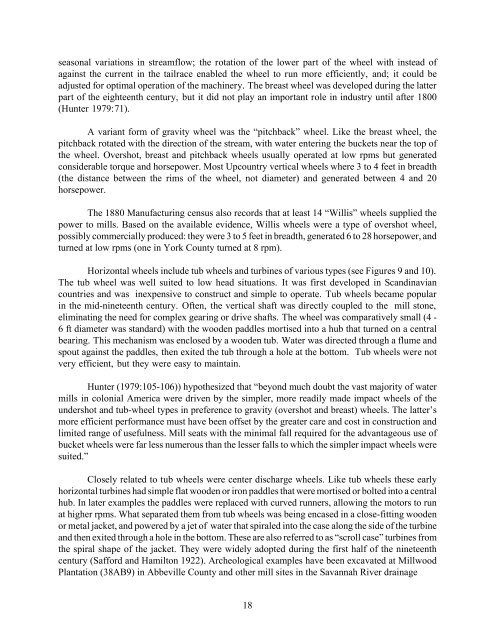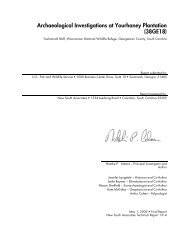Mills in the Upcountry: a Historic Context, and a Summary of a Mill ...
Mills in the Upcountry: a Historic Context, and a Summary of a Mill ...
Mills in the Upcountry: a Historic Context, and a Summary of a Mill ...
You also want an ePaper? Increase the reach of your titles
YUMPU automatically turns print PDFs into web optimized ePapers that Google loves.
seasonal variations <strong>in</strong> streamflow; <strong>the</strong> rotation <strong>of</strong> <strong>the</strong> lower part <strong>of</strong> <strong>the</strong> wheel with <strong>in</strong>stead <strong>of</strong><br />
aga<strong>in</strong>st <strong>the</strong> current <strong>in</strong> <strong>the</strong> tailrace enabled <strong>the</strong> wheel to run more efficiently, <strong>and</strong>; it could be<br />
adjusted for optimal operation <strong>of</strong> <strong>the</strong> mach<strong>in</strong>ery. The breast wheel was developed dur<strong>in</strong>g <strong>the</strong> latter<br />
part <strong>of</strong> <strong>the</strong> eighteenth century, but it did not play an important role <strong>in</strong> <strong>in</strong>dustry until after 1800<br />
(Hunter 1979:71).<br />
A variant form <strong>of</strong> gravity wheel was <strong>the</strong> “pitchback” wheel. Like <strong>the</strong> breast wheel, <strong>the</strong><br />
pitchback rotated with <strong>the</strong> direction <strong>of</strong> <strong>the</strong> stream, with water enter<strong>in</strong>g <strong>the</strong> buckets near <strong>the</strong> top <strong>of</strong><br />
<strong>the</strong> wheel. Overshot, breast <strong>and</strong> pitchback wheels usually operated at low rpms but generated<br />
considerable torque <strong>and</strong> horsepower. Most <strong>Upcountry</strong> vertical wheels where 3 to 4 feet <strong>in</strong> breadth<br />
(<strong>the</strong> distance between <strong>the</strong> rims <strong>of</strong> <strong>the</strong> wheel, not diameter) <strong>and</strong> generated between 4 <strong>and</strong> 20<br />
horsepower.<br />
The 1880 Manufactur<strong>in</strong>g census also records that at least 14 “Willis” wheels supplied <strong>the</strong><br />
power to mills. Based on <strong>the</strong> available evidence, Willis wheels were a type <strong>of</strong> overshot wheel,<br />
possibly commercially produced: <strong>the</strong>y were 3 to 5 feet <strong>in</strong> breadth, generated 6 to 28 horsepower, <strong>and</strong><br />
turned at low rpms (one <strong>in</strong> York County turned at 8 rpm).<br />
Horizontal wheels <strong>in</strong>clude tub wheels <strong>and</strong> turb<strong>in</strong>es <strong>of</strong> various types (see Figures 9 <strong>and</strong> 10).<br />
The tub wheel was well suited to low head situations. It was first developed <strong>in</strong> Sc<strong>and</strong><strong>in</strong>avian<br />
countries <strong>and</strong> was <strong>in</strong>expensive to construct <strong>and</strong> simple to operate. Tub wheels became popular<br />
<strong>in</strong> <strong>the</strong> mid-n<strong>in</strong>eteenth century. Often, <strong>the</strong> vertical shaft was directly coupled to <strong>the</strong> mill stone,<br />
elim<strong>in</strong>at<strong>in</strong>g <strong>the</strong> need for complex gear<strong>in</strong>g or drive shafts. The wheel was comparatively small (4 -<br />
6 ft diameter was st<strong>and</strong>ard) with <strong>the</strong> wooden paddles mortised <strong>in</strong>to a hub that turned on a central<br />
bear<strong>in</strong>g. This mechanism was enclosed by a wooden tub. Water was directed through a flume <strong>and</strong><br />
spout aga<strong>in</strong>st <strong>the</strong> paddles, <strong>the</strong>n exited <strong>the</strong> tub through a hole at <strong>the</strong> bottom. Tub wheels were not<br />
very efficient, but <strong>the</strong>y were easy to ma<strong>in</strong>ta<strong>in</strong>.<br />
Hunter (1979:105-106)) hypo<strong>the</strong>sized that “beyond much doubt <strong>the</strong> vast majority <strong>of</strong> water<br />
mills <strong>in</strong> colonial America were driven by <strong>the</strong> simpler, more readily made impact wheels <strong>of</strong> <strong>the</strong><br />
undershot <strong>and</strong> tub-wheel types <strong>in</strong> preference to gravity (overshot <strong>and</strong> breast) wheels. The latter’s<br />
more efficient performance must have been <strong>of</strong>fset by <strong>the</strong> greater care <strong>and</strong> cost <strong>in</strong> construction <strong>and</strong><br />
limited range <strong>of</strong> usefulness. <strong>Mill</strong> seats with <strong>the</strong> m<strong>in</strong>imal fall required for <strong>the</strong> advantageous use <strong>of</strong><br />
bucket wheels were far less numerous than <strong>the</strong> lesser falls to which <strong>the</strong> simpler impact wheels were<br />
suited.”<br />
Closely related to tub wheels were center discharge wheels. Like tub wheels <strong>the</strong>se early<br />
horizontal turb<strong>in</strong>es had simple flat wooden or iron paddles that were mortised or bolted <strong>in</strong>to a central<br />
hub. In later examples <strong>the</strong> paddles were replaced with curved runners, allow<strong>in</strong>g <strong>the</strong> motors to run<br />
at higher rpms. What separated <strong>the</strong>m from tub wheels was be<strong>in</strong>g encased <strong>in</strong> a close-fitt<strong>in</strong>g wooden<br />
or metal jacket, <strong>and</strong> powered by a jet <strong>of</strong> water that spiraled <strong>in</strong>to <strong>the</strong> case along <strong>the</strong> side <strong>of</strong> <strong>the</strong> turb<strong>in</strong>e<br />
<strong>and</strong> <strong>the</strong>n exited through a hole <strong>in</strong> <strong>the</strong> bottom. These are also referred to as “scroll case” turb<strong>in</strong>es from<br />
<strong>the</strong> spiral shape <strong>of</strong> <strong>the</strong> jacket. They were widely adopted dur<strong>in</strong>g <strong>the</strong> first half <strong>of</strong> <strong>the</strong> n<strong>in</strong>eteenth<br />
century (Safford <strong>and</strong> Hamilton 1922). Archeological examples have been excavated at <strong>Mill</strong>wood<br />
Plantation (38AB9) <strong>in</strong> Abbeville County <strong>and</strong> o<strong>the</strong>r mill sites <strong>in</strong> <strong>the</strong> Savannah River dra<strong>in</strong>age<br />
18







